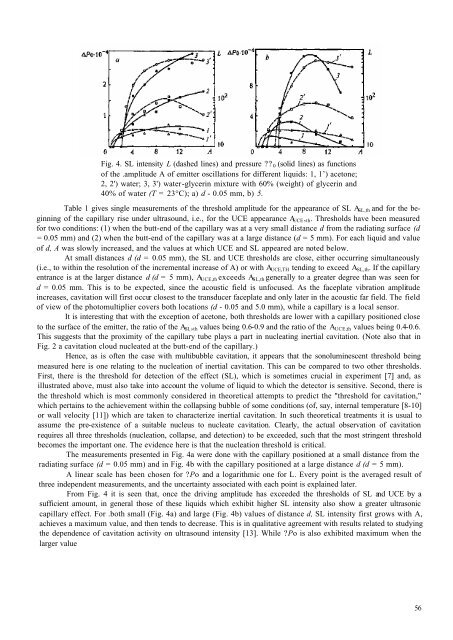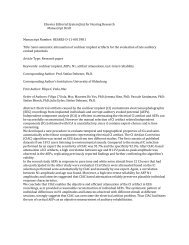study into correlation between the ultrasonic capillary effect and ...
study into correlation between the ultrasonic capillary effect and ...
study into correlation between the ultrasonic capillary effect and ...
You also want an ePaper? Increase the reach of your titles
YUMPU automatically turns print PDFs into web optimized ePapers that Google loves.
Fig. 4. SL intensity L (dashed lines) <strong>and</strong> pressure ?? 0 (solid lines) as functions<br />
of <strong>the</strong> .amplitude A of emitter oscillations for different liquids: 1, 1’) acetone;<br />
2, 2') water; 3, 3') water-glycerin mixture with 60% (weight) of glycerin <strong>and</strong><br />
40% of water (T = 23°C); a) d - 0.05 mm, b) 5.<br />
Table 1 gives single measurements of <strong>the</strong> threshold amplitude for <strong>the</strong> appearance of SL ASL,th <strong>and</strong> for <strong>the</strong> beginning<br />
of <strong>the</strong> <strong>capillary</strong> rise under ultrasound, i.e., for <strong>the</strong> UCE appearance AUCE,th. Thresholds have been measured<br />
for two conditions: (1) when <strong>the</strong> butt-end of <strong>the</strong> <strong>capillary</strong> was at a very small distance d from <strong>the</strong> radiating surface (d<br />
= 0.05 mm) <strong>and</strong> (2) when <strong>the</strong> butt-end of <strong>the</strong> <strong>capillary</strong> was at a large distance (d = 5 mm). For each liquid <strong>and</strong> value<br />
of d, A was slowly increased, <strong>and</strong> <strong>the</strong> values at which UCE <strong>and</strong> SL appeared are noted below.<br />
At small distances d (d = 0.05 mm), <strong>the</strong> SL <strong>and</strong> UCE thresholds are close, ei<strong>the</strong>r occurring simultaneously<br />
(i.e., to within <strong>the</strong> resolution of <strong>the</strong> incremental increase of A) or with AUCE,TH tending to exceed ASL,th. If <strong>the</strong> <strong>capillary</strong><br />
entrance is at <strong>the</strong> larger distance d (d = 5 mm), AUCE,th exceeds ASL,th generally to a greater degree than was seen for<br />
d = 0.05 mm. This is to be expected, since <strong>the</strong> acoustic field is unfocused. As <strong>the</strong> faceplate vibration amplitude<br />
increases, cavitation will first occur closest to <strong>the</strong> transducer faceplate <strong>and</strong> only later in <strong>the</strong> acoustic far field. The field<br />
of view of <strong>the</strong> photomultiplier covers both locations (d - 0.05 <strong>and</strong> 5.0 mm), while a <strong>capillary</strong> is a local sensor.<br />
It is interesting that with <strong>the</strong> exception of acetone, both thresholds are lower with a <strong>capillary</strong> positioned close<br />
to <strong>the</strong> surface of <strong>the</strong> emitter, <strong>the</strong> ratio of <strong>the</strong> ASL,th values being 0.6-0.9 <strong>and</strong> <strong>the</strong> ratio of <strong>the</strong> AUCE,th values being 0.4-0.6.<br />
This suggests that <strong>the</strong> proximity of <strong>the</strong> <strong>capillary</strong> tube plays a part in nucleating inertial cavitation. (Note also that in<br />
Fig. 2 a cavitation cloud nucleated at <strong>the</strong> butt-end of <strong>the</strong> <strong>capillary</strong>.)<br />
Hence, as is often <strong>the</strong> case with multibubble cavitation, it appears that <strong>the</strong> sonoluminescent threshold being<br />
measured here is one relating to <strong>the</strong> nucleation of inertial cavitation. This can be compared to two o<strong>the</strong>r thresholds.<br />
First, <strong>the</strong>re is <strong>the</strong> threshold for detection of <strong>the</strong> <strong>effect</strong> (SL), which is sometimes crucial in experiment [7] <strong>and</strong>, as<br />
illustrated above, must also take <strong>into</strong> account <strong>the</strong> volume of liquid to which <strong>the</strong> detector is sensitive. Second, <strong>the</strong>re is<br />
<strong>the</strong> threshold which is most commonly considered in <strong>the</strong>oretical attempts to predict <strong>the</strong> "threshold for cavitation,"<br />
which pertains to <strong>the</strong> achievement within <strong>the</strong> collapsing bubble of some conditions (of, say, internal temperature [8-10]<br />
or wall velocity [11]) which are taken to characterize inertial cavitation. In such <strong>the</strong>oretical treatments it is usual to<br />
assume <strong>the</strong> pre-existence of a suitable nucleus to nucleate cavitation. Clearly, <strong>the</strong> actual observation of cavitation<br />
requires all three thresholds (nucleation, collapse, <strong>and</strong> detection) to be exceeded, such that <strong>the</strong> most stringent threshold<br />
becomes <strong>the</strong> important one. The evidence here is that <strong>the</strong> nucleation threshold is critical.<br />
The measurements presented in Fig. 4a were done with <strong>the</strong> <strong>capillary</strong> positioned at a small distance from <strong>the</strong><br />
radiating surface (d = 0.05 mm) <strong>and</strong> in Fig. 4b with <strong>the</strong> <strong>capillary</strong> positioned at a large distance d (d = 5 mm).<br />
A linear scale has been chosen for ?Po <strong>and</strong> a logarithmic one for L. Every point is <strong>the</strong> averaged result of<br />
three independent measurements, <strong>and</strong> <strong>the</strong> uncertainty associated with each point is explained later.<br />
From Fig. 4 it is seen that, once <strong>the</strong> driving amplitude has exceeded <strong>the</strong> thresholds of SL <strong>and</strong> UCE by a<br />
sufficient amount, in general those of <strong>the</strong>se liquids which exhibit higher SL intensity also show a greater <strong>ultrasonic</strong><br />
<strong>capillary</strong> <strong>effect</strong>. For .both small (Fig. 4a) <strong>and</strong> large (Fig. 4b) values of distance d, SL intensity first grows with A,<br />
achieves a maximum value, <strong>and</strong> <strong>the</strong>n tends to decrease. This is in qualitative agreement with results related to <strong>study</strong>ing<br />
<strong>the</strong> dependence of cavitation activity on ultrasound intensity [13]. While ?Po is also exhibited maximum when <strong>the</strong><br />
larger value<br />
56
















